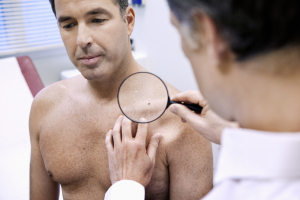Tinea versicolor is a yeast infection of the skin caused by Pityrosporum orbicular (formerly called Malassezia furfur). It produces painless patches of lesions that come in different color such as white, brownish or pinkish. They tend to scale a bit and are found mainly on the neck, chest and abdomen. Here is a picture of tinea versicolor of the chest wall.
In summer it may be more noticeable because the fungus filters the UV light and the affected skin will not tan as well as the surrounding healthy skin. It occurs preferably in young adults. The diagnosis is largely made clinically by experience. However, in case of doubts the dermatologist may want to take scrapings and look under the microscope for characteristic hyphae. In addition under the Wood’s light the dermatologist will see the true extent of distribution as the spots with tinea versicolor will produce golden fluorescence, but normal skin not.
Treatment
Various therapeutic modalities will treat Tinea versicolor. One of the more popular and cheap methods is selenium sulfide 2.5% shampoo (Versel shampoo). Other effective ways are clotrimazole (brand name: Canesten cream or solution) or ketoconazole (brand name: Nizoral cream or shampoo). In more difficult to treat cases itraconazole (brand name: Sporanox) 200 mg once daily is given for about 1 week (Ref. 5, p.805).
References:
1.The Merck Manual, 7th edition, by M. H. Beer s et al., Whitehouse Station, N.J., 1999. Chapter 158.
2.The Merck Manual, 7th edition, by M. H. Beers et al., Whitehouse Station, N.J., 1999. Chapter 113.
3. The Merck Manual, 7th edition, by M. H. Beers et al., Whitehouse Station, N.J., 1999. Chapter 164.
4.David Heymann, MD, Editor: Control of Communicable Diseases Manual, 18th Edition, 2004, American Public Health Association.







